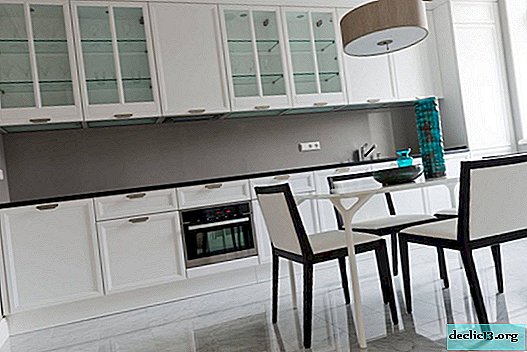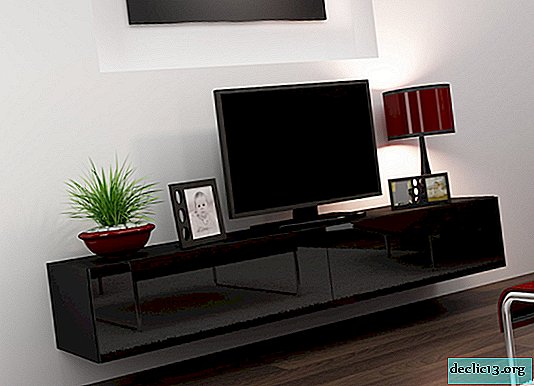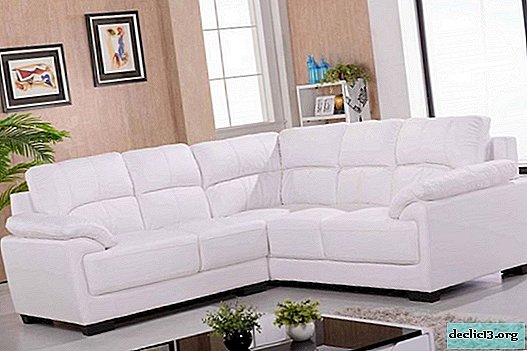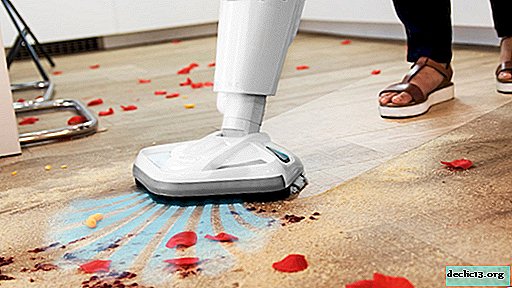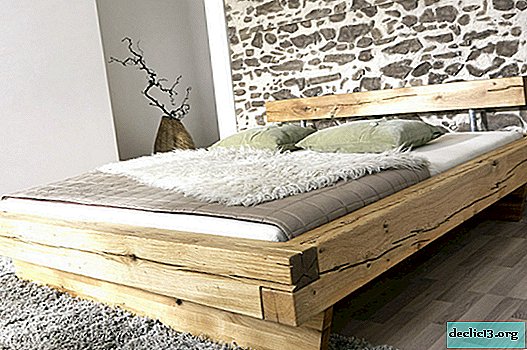Functional characteristics of a sewing table, DIY assembly
Each beginning seamstress needs to organize the workplace correctly. To do this, you need a table for sewing, which you can do yourself. Having a specialized workplace will allow you to work with great comfort and save time. In addition, having his own corner, the master will not interfere with homework, and the entire instrument will be stored in one place.
Design features
In the modern sense, a sewing table is a kind of transformer. When folded, it is a compact nightstand, which, if necessary, is displayed in a full-fledged workplace. The cutting table for the sewing machine is ergonomic and has great functionality. You can completely hide the equipment in it. Inside, the product is equipped with many drawers of different sizes, spiers for coils, shelves. The main task of the sewing table is to make the master's many hours of work more comfortable.
Having a specialized workplace, a seamstress can easily make cutting, apply patterns. All tools will be at hand, and the machine will not move out during operation. In addition, if there are small children at home, a folding transformer will protect children from sharp and dangerous objects, which is almost impossible when working at a regular desk.


Varieties
The modern furniture market offers a wide selection of ways to organize a workplace for needlewomen. Tables for sewing are presented in several forms:
- Classical. Designed for household or industrial sewing machines and accessories. They are equipped with all the ateliers, as well as large factories. The sewing machine is firmly fixed to the work surface. Such a table does not fold, but is adjustable in height, which is very convenient for owners of high growth.
- Multifunctional. Often done corner, includes several basic and additional modules. Some models can be folded compactly into one large stand. In such a sewing table, many sections, compartments, drawers are often made. It looks like a full-fledged workplace. Most models have a surface for cutting.
- With recessed lighting. Such products are represented by a wide variety of models. The main advantage is the presence of built-in lights that provide proper illumination of the working surface.
- Table transformer. When unfolded, it is a spacious workplace with many compartments for storing the necessary trifles, when folded, it is a regular folding table that can be used as a desk.
- Book. The budget and most simple table for needlework, consisting of three or more sections, one of which is stationary, and the rest are laid out as necessary. Often, such models are equipped with compartments for storing a sewing machine and accessories. The main advantage is the ability to adjust the height of the table.
- Angular. A larger model with a spacious work surface. It allows you to cut, sew and produce all the necessary work without changing the position.
- Professional table for cutting and plotting patterns. It is often more convenient for seamstresses to work at large tables, on which both the sewing machine and the cutting surface are located. The model is suitable for those who are constantly engaged in sewing.
- Cabinet with storage sections. The most budget option. Actually, this is an ordinary bedside table, in which there are boxes and shelves for the dimensions of the sewing inventory. Often a folding tabletop is attached to them, bolted to the hinged stand. The main advantage of this model is its compact size.
Of course, for a hobby in the form of clothing, any table with or without a drawer is suitable, but if sewing becomes the main profession, it is advisable to give preference to special products that are adjustable in height and have a large working surface. Since only the correct and comfortable position of the body during long work will help maintain spinal health.
 Classical
Classical Book
Book Multifunctional
Multifunctional Professional
Professional Table transformer
Table transformer Angular
Angular Stand
StandMaterials of manufacture
When choosing a folding table for needlework, it is important to consider the weight and strength of the material from which it is made. Sewing tables often fold and unfold, which directly affects their durability and ease of use. In addition, in the sewing business can not do without an iron, the temperature from which can also affect the condition of the work surface.
The following types of materials are used for the production of this furniture:
- Array of wood. By purchasing a sewing table from this material, the master receives the most durable and wear-resistant working tool. Such an attribute will fit perfectly into the interior of any room. The array is not afraid of high temperatures, so you can put a hot iron on it. Among the shortcomings of such models, it can be distinguished that the furniture made of wood is rather heavy and expensive.
- MDF. The main advantage of this material is ease of processing, low weight and low cost. Even an unskilled worker with a minimum set of tools will be able to independently collect a workplace from such material. Tables made of MDF are often made on wheels, which provides good mobility, and the light weight of the furniture does not allow scratching the floor covering. The disadvantages of MDF boards include fragility, fear of moisture and high temperatures. The coating of especially cheap stoves can swell if you put a mug of boiling water, so work with steam will not work, unless putting an additional protective coating.
- Chipboard. Perhaps the cheapest and most impractical material. Particleboard furniture has an attractive appearance, a small mass, but is afraid of moisture and high temperatures, emits toxic substances and does not withstand heavy loads.
- Chipboard. The optimal material for the sewing table is a laminated chipboard. Pressed sawdust with the addition of special resins makes this material durable, environmentally friendly (subject to production standards), resistant to high temperatures, easy to process, and therefore quite cheap. A variety of materials will help optimally fit the table for the sewing machine into any interior.
Although today chipboard is the most popular material in the furniture industry, it has several significant drawbacks - it is afraid of water, formaldehyde can be released during improper production, can hardly be repaired, is relatively fragile and does not withstand heavy physical loads.
 Chipboard
Chipboard Chipboard
Chipboard Solid wood
Solid wood MDF
MDFHow to choose
When choosing a table for cutting and sewing, it is necessary to consider several nuances:
- Area of the future workshop. Often, seamstresses choose small rooms for work, in which only compact models of furniture can be placed. The best option in such cases are tables, tables, books. For more spacious workshops, transformers are perfect.
- The size of the sewing machine. Most modern household machines are quite modest in size, but if the master has one of the advanced or industrial models, then you can’t hide it in a small-sized sewing table, in such cases it is better to choose universal products.
- Workplace mobility. Noise from a sewing machine can interfere with other family members. If the table is small, light and mounted on wheels, it will not be difficult for a seamstress to quickly move the workplace to another part of the apartment.
Also, choosing a place for work, it is necessary to take into account the distance from the outlets, the presence of natural or artificial lighting, the ability to hang up finished products and roll out the fabric in order to measure the desired size.
 Take into account the area of the future workshop and the dimensions of the machine
Take into account the area of the future workshop and the dimensions of the machineHow to make a universal table for sewing yourself
For those who can read the drawings, handle a jigsaw, screwdriver and tape measure, making a universal sewing table is not difficult. The model in question does not take up much space and does not require expensive materials. Another advantage of this table is that it is mobile and contains everything you need. To make it you will need:
- 5 furniture wheels;
- 1 latch;
- MDF or chipboard;
- lock (can be taken from the old cabinet);
- shelves (purchased at a hardware store or made from food containers);
- hinges for the top cover and door, which should open more than 180 degrees;
- system for lifting machines (ask at sewing shops).
 Chipboard
Chipboard Furniture wheels
Furniture wheels System for lifting machines
System for lifting machines Hinges
Hinges Espagnolette
EspagnoletteStep-by-step instruction:
- Cut lumber to the dimensions indicated on the drawing.
- Tie the design with screws.
- Place the hinged lid and door onto the hinges, screw the latch, insert the lock.
- Saw a hole in the cover to fit the size of the sewing machine.
- Install the lift, and screw the cut piece to the lifting system.
- If holes are provided in the machine, the equipment can be attached to the lifting system.
- Attach compartments for storing tools and accessories to the inside of the door using self-tapping screws.
- The last step is to fasten the wheels.
The maximum time for such work is no more than 3-4 hours. The trimmed sides of wood boards must be glued with furniture tape. Otherwise, there is a risk of injuring your hands or ruining the fabric on a rough surface.
A home-made sewing table saves the craftsman's budget, and in its operational characteristics is not inferior to factory options. In addition, the needlewoman has the opportunity to make changes to the drawing or independently design a table, according to her needs.
 Drawing
Drawing Cut lumber to size
Cut lumber to size Fasten the structure with screws
Fasten the structure with screws Saw a hole in the cover for the size of the sewing machine
Saw a hole in the cover for the size of the sewing machine Collect all the details
Collect all the details Install and secure the machine
Install and secure the machine





















